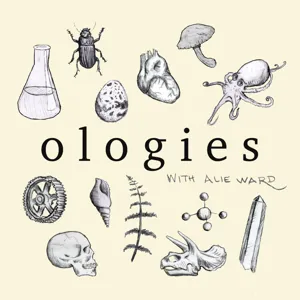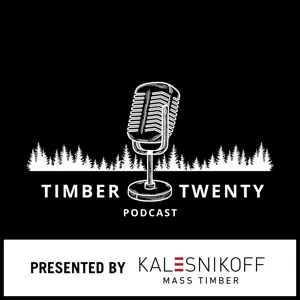Podcast Summary
Exploring the Fascinating World of Wood with Angel City Lumber: The fifth anniversary episode of Ologies celebrated wood through an interview with Jeff Perry of Angel City Lumber, emphasizing the importance of valuing wood's natural beauty and utility in our daily lives.
The fifth anniversary of the Ologies podcast was celebrated with a wood-themed episode, featuring an interview with Jeff Perry, co-founder of Angel City Lumber. The podcast, which deals with various scientific "ologies," explored the branch of dendrology called xylology, which focuses on the structure of wood. Jeff and the host, Ally Ward, discussed various aspects of wood, from sawdust to tree diseases, salvaged lumber, and more. Angel City Lumber sources its wood from urban trees and is a popular resource for local furniture builders and carpenters. Despite not being traditional lumberjacks, Jeff and his team at Angel City Lumber are passionate about wood and its many uses. The episode underscores the importance of appreciating the natural world and the beauty and utility of wood in particular.
Repurposing Downed Trees: A Sustainable Solution: By salvaging downed trees and turning them into locally sourced lumber, we can reduce waste, support local businesses, and create a more sustainable supply chain.
There's a significant opportunity to reduce waste and support local businesses by repurposing downed trees instead of mulching them. This was the inspiration behind the creation of Angel City Lumber. When trees fall, the initial reaction is often to remove them quickly due to liability concerns and the perception that dead trees are a nuisance. However, this results in a lot of valuable wood being wasted. Instead, by working with tree services and the design community, it's possible to salvage these trees and turn them into locally sourced lumber. Mulch is beneficial for retaining moisture and suppressing weeds, but it's important to avoid mulching large branches and trunks of fallen trees. By changing our approach to downed trees, we can reduce waste, support local businesses, and create a more sustainable supply chain.
Changing the way we view and harvest trees: Advocate for local production of lumber from local trees to shift the way we harvest commercial wood, reducing environmental impact.
Our disconnect with trees in Western culture has led to the widespread practice of mulching trees instead of disposing them in landfills. This disconnect is so profound that many people don't even consider the origin of wood products, such as lumber or mulch. Commercial lumber, which is often used for construction, is typically sourced from secession-planted forests, where trees are grown for a specific period and then harvested to make way for new growth. This process is efficient but lacks the honor and respect for trees as living beings. The hyperlocal model advocated by Angel City aims to change this by encouraging every local community to produce its own lumber from local trees, whether they are felled due to development, disease, or storm damage. By doing so, we can shift the way we harvest commercial lumber and reduce the environmental impact of our wood consumption.
Forming Emotional Connections with Trees: Considering the emotional bonds we form with trees and valuing them beyond their practical uses can lead to deeper appreciation and better treatment of natural resources.
Our connection to natural resources, such as trees, goes beyond their practical uses. When we form personal connections to these resources, we value them more deeply. The speaker shares an example of a tree that holds significant emotional importance to people, but once it's cut down, it becomes a nuisance. However, if we could reconnect with the idea that everything has a spirit and a soul, like in the days of animism, we might treat trees differently. Instead of seeing them as objects to be harvested, we could appreciate them for their beauty and the role they play in our lives. The speaker suggests that we should get acquainted with the trees in our community, touch them, and think about them differently when we harvest wood from them. The classic children's book "The Giving Tree" illustrates this idea beautifully, as it shows the emotional bond between a boy and an apple tree that grows weaker as the boy takes more and more from it. The speaker also mentions that they found it relatively easy to obtain tree logs from people who were willing to give them away, but it was a challenge to ensure they got the right size and diameter. Overall, the speaker encourages us to reconsider our relationship with trees and other natural resources and to value the emotional connections we form with them.
From tree log to table: A complex journey: Transforming a tree log into a table involves careful handling, cutting, drying, and patience.
Transforming a tree log into a table involves several steps beyond just cutting it into boards. The process starts with sourcing logs, which was relatively easy for the speaker in the beginning, but requires careful handling and transportation. Once the log is milled, it's cut into different types of boards based on the grain pattern: plain sawn, rift sawn, and quarter sawn. Each cut has unique grain patterns and properties. After cutting, the boards need to be dried to remove the free water and reduce the moisture content. This process can take several months. The speaker emphasizes that building with wet material can lead to warping and off-gassing, making it essential to let the wood dry before construction. Overall, the journey from a tree log to a table is a complex one that involves careful planning, execution, and patience.
Working with wood: patience and precision: Transforming wood into usable building materials requires patience, precision, and a deep understanding of its unique properties.
Working with wood, whether it's air-dried or kiln-dried, requires patience and precision. Air-drying wood can take a year or more per inch of thickness, while kiln-drying speeds up the process but requires careful handling to prevent damage. Once the wood is dried, it needs to be surfaced and planed to make it buildable. Urban environments often use resilient trees for their urban forests, such as London plane trees, which can be found in various cities across the country. These trees, while beautiful and useful, may not be commonly used for commercial wood products due to their classification as canopy or ornamental trees rather than wood trees. Despite this, many of these trees have historical significance and were once used in construction. Overall, working with wood involves a deep understanding of its unique properties and the processes required to transform it into usable building materials.
Utilizing Underutilized Tree Species for Sustainable Lumber: Underutilized tree species, like Canary Island pine, eucalyptus, and coast live oak, offer sustainability benefits and excellent alternatives to chemically treated lumber for ground contact applications. Companies are repurposing urban trees into sustainable lumber, reducing the need for deforestation.
There are underutilized tree species, such as the Canary Island pine, which are naturally resistant to decay and moisture, making them excellent alternatives to chemically treated lumber for ground contact applications. These trees offer sustainability benefits and can be sourced from urban areas, reducing the need for deforestation. For instance, the Canary Island pine is so resinous that it oozes natural pitch, making it an ideal choice for such uses. Other tree species, like eucalyptus and coast live oak, are commonly used for flooring due to their hardness, density, and high foot traffic durability. Companies like New York City Slab, Wood from the Hood, Epilogue LLC, Bay Area Redwood, Harvest Lumber, San Diego Urban Timber, Lumber Cycle, Allesaw, and Street Tree Revival are just a few examples of those repurposing urban trees as lumber.
Exploring the Unique Properties of Eucalyptus Wood: Eucalyptus, often criticized for instability, can be a great choice for furniture making and joinery. Challenging preconceived notions and considering unique characteristics of each wood species leads to informed decisions and appreciation for diverse options.
There are various types of woods, both hardwood and softwood, each with unique properties suitable for different applications. While some woods, like walnut, are widely recognized for their beauty and durability, others, like eucalyptus, have been unfairly dismissed. Eucalyptus, native to Australia, has been criticized for being unstable and difficult to work with, but it can actually be an excellent choice for furniture making and joinery. It's essential to challenge preconceived notions and explore the unique characteristics of each wood species to make informed decisions and appreciate the full range of options available. Additionally, using reclaimed and native materials is a sustainable approach to landscape design and interior furnishings.
European settlers imported eucalyptus trees to California due to a perceived timber famine: Human actions, driven by resource needs, can lead to the unintended introduction and dominance of non-native species in new ecosystems.
The European settlers in Australia, driven by their need for wood for energy, building materials, and railroad ties during the gold rush era, imported eucalyptus trees from Australia due to a perceived timber famine. Despite the confusion about which species to import, they began planting eucalyptus trees in California, leading to their widespread growth and eventual dominance in the landscape. This history highlights the significant impact of human actions on non-native ecosystems and the unintended consequences of introducing non-native species.
The challenges of harvesting and processing eucalyptus wood: Despite initial promise, eucalyptus wood proved difficult to harvest and process due to unique growth patterns, leading to wasted resources and damaged reputations. Innovations in drying technology have since improved management and utilization.
The eucalyptus tree, which was once seen as a savior for timber production and investment opportunities on the West Coast, turned out to be a challenge due to its unique growth patterns and harvesting methods. The trees were harvested too early, leading to issues with warping, buckling, and cross grain. This resulted in wasted resources and damaged reputations. However, recent advancements in drying technology, such as kiln drying, have allowed for better management and utilization of eucalyptus wood. It's important to consider the long-term implications of harvesting and processing methods, as well as the cultural perceptions that can shape our attitudes towards certain resources. The eucalyptus tree serves as a reminder of the importance of research, innovation, and adaptability in the face of challenges.
Controlling moisture and temperature during eucalyptus lumber kiln drying: Eucalyptus lumber's natural beauty is preserved through careful kiln drying processes, allowing its use in various applications like decking and flooring.
The process of producing high-quality eucalyptus lumber involves carefully controlling the moisture and temperature during kiln drying to ensure stable drying and maintain the natural beauty of the wood. Eucalyptus species like blue gum, lemon scented gum, red gum, and sugar gum are commonly used for decking, flooring, and other applications. The industry shift to stick framing and the desire for efficiency led to the naming of lumber as "2 by fours," despite their actual dimensions. Wood's hardness comes from the presence of lignin, which acts as a binder between cells and gives wood its structural strength.
Lignin in Asparagus and Spalting in Wood: Lignin gives wood strength but negatively impacts asparagus quality. Spalting in wood is a fungal characteristic that can be encouraged for unique patterns.
Lignin, a polymer found in wood, acts as a binder for cellulose and gives wood its strength. However, in asparagus, lignification negatively affects its quality and limits marketability after harvest. Meanwhile, spalting in wood is a fungal characteristic that results in unique patterns, but it doesn't necessarily harm or help the tree. Lastly, burls are sprouts in trees that don't necessarily continue to shoot, and some species, like walnut, have more of them. Redwoods also have lignotubers, which are similar to burls but continue to grow. The discussion also touched upon the role of fungi in trees, with mycorrhizal fungi providing support and other fungi potentially causing harm. Additionally, spalting can be encouraged intentionally by adding nitrogen-rich materials to the wood.
Old growth forests: Untouched forests with human signs: Old growth forests, naturally regenerated over centuries, play a crucial role in carbon storage and species preservation. They're highly valued for their dense growth rings and dark color, but overharvesting of some tree species is a concern. Respecting natural tree processes is essential.
Old growth forests are naturally regenerated, untouched forests with visible signs of human activity, and they play a crucial role in storing carbon and preserving species. Old growth forests are typically defined as forests that have not been logged, and they are found mostly in Brazil, Canada, and Russia. The process of turning second or new growth forests into old growth can take hundreds to thousands of years. Old growth wood, whether it's found in lakes or bogs, is highly valued for its dense growth rings and beautiful, dark color. However, some tree species, such as mahogany, are overharvested and may need more sustainable harvesting practices. The loss of old growth forests due to logging is a significant issue, and it's important for us to consider the long-term impact of our actions on forests and the environment. The discussion also touched on the importance of respecting the natural processes of trees, such as the formation of burls, which can be a sign of stress or a response to environmental challenges.
Sustainable forest management practices for healthier ecosystems: Sustainable forest management practices, like coppicing and pollarding, support greater biodiversity by creating diverse habitats and resources for various species. Reclaimed wood and barn wood are also eco-friendly building materials.
Sustainable forest management practices, such as coppicing and pollarding, can lead to healthier ecosystems with increased biodiversity. These practices, which involve selectively cutting trees and allowing them to regrow, have been used for centuries by indigenous communities and pre-industrial societies. According to the book "Sproutlands" by William Bryant Logan, these practices can support three times more plant, insect, bird, and other creature species than an untouched woodland. This is because the diverse landscape created by human participation provides a variety of habitats and resources for different species. Additionally, reclaimed wood and barn wood are viable options for sustainable building materials, and there are resources available for sourcing and using these materials. However, implementing these practices and sourcing these materials requires a shift in mindset from commoditizing natural resources for their sake to valuing their ecological and cultural significance.
Preserving natural resources with reclaimed timber, but challenges remain in utilizing the entire log: Reclaimed timber offers an eco-friendly solution for furniture production, but finding innovative uses for the remaining 20% of the log is a challenge. Authenticity and personal connections are valued in the industry, and reducing waste remains a priority.
The process of extracting and repurposing reclaimed timber is an efficient and cost-effective way to preserve natural resources, but the challenge lies in finding innovative uses for the remaining 20% of the log that cannot be turned into lumber. This issue crushes the soul of those in the industry, as they strive to minimize waste and make the most of every tree. The discussion also highlighted the importance of authenticity in the furniture industry, with the speaker expressing frustration towards misrepresented live edge furniture. Personal connections and cherished pieces, such as a beloved live edge table, hold significant value. Moreover, the team behind the reclaimed lumber business was praised for their dedication and passion towards their work. They have made great strides, but continue to seek innovative solutions for utilizing the entire log and reducing waste. Additionally, the speaker shared their favorite smelling wood, Deodar cedar, and encouraged listeners to follow Angle Sealumber for ideas and to appreciate their stunning stumps and slabs.
Appreciating the Connection Between Humans and Trees: Embrace the beauty and reverence of nature, including the importance of dealing with death in a natural way, and the joy of asking deep questions. Utilize resources like books and companies to foster a deeper connection with the natural world.
The discussion revolved around the appreciation of the natural world, specifically the connection between humans and trees. The speaker, Jeff, expressed the importance of acknowledging the living beings around us, including trees, and the significance of death in this process. He emphasized the beauty and reverence of dealing with death in a natural way, and the importance of communing with nature. Additionally, the speaker mentioned the joy of asking deep questions and the importance of various resources, such as books and companies, in fostering this connection with nature. The overall sentiment was one of respect and reverence for the natural world and the importance of embracing all parts of it, including the often overlooked or discarded parts.




